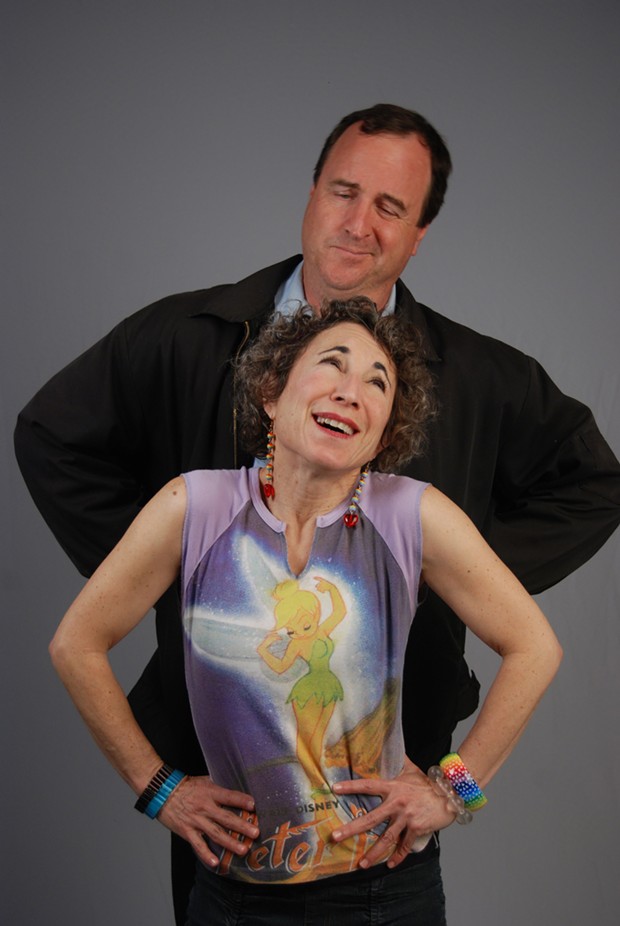[
{
"name": "Top Stories Video Pair",
"insertPoint": "7",
"component": "17087298",
"parentWrapperClass": "fdn-ads-inline-content-block",
"requiredCountToDisplay": "1"
}
]
Healthy families are all alike, but every dysfunctional family is dysfunctional in its own way. Which for playwrights from the Greeks to Eugene O'Neill onwards has been money in the bank. David Lindsay-Abaire studied playwriting at Julliard with Christopher Durang and Marsha (‘Night, Mother) Norman. He wrote the dysfunctional family of Kimberly Akimbo as if he was their love child, combining innocence and addictions, whimsy and noisy desperation in the wilds of working class New Jersey.
The production now on the Redwood Curtain stage in Eureka is introduced by theme songs from '50s and '60s family sitcoms, but this is more like the 1990s Married...With Children meeting the solemn surrealism of 2011 reality TV.
Kimberly Lavaco (played by Adina Lawson) is turning 16, which is the average life expectancy for her rare genetic disorder that causes her to age more than four times faster than normal. Her dad is Buddy (James Hitchcock), an alcoholic gas station booth attendant who promises to take the family to a Six Flags amusement park with a new African safari attraction, but never does. Her mother is Pattie (Elisa Abelleira), who is very pregnant and has both arms in casts from a purported carpel tunnel syndrome surgery. She says she's dying of cancer (she isn't) and so must spill her thoughts into a tape recorder for her unborn daughter.
Pattie's sister Debra (Peggy Metzger) is a homeless petty criminal who has lived in their basement, and is the moving force both in their past and in the crime that is planned and committed during the play. She's also the closest to Kimberly.
We learn of Kimberly's condition thanks to the cluelessly sincere interest of her high school classmate Jeff, whose own unseen family includes a criminal brother and neglectful father. He stays afloat with enthusiasms for Dungeons and Dragons and anagrams (the play was written in 2000, before similar teens moved on to newer obsessions).
Lawson brings Kimberly to life with an adept performance that centers the play. But this is really an ensemble production, and all the actors define specific characters that create both comic and dramatic moments, sometimes simultaneously. Metzger's performance is so physically expressive that Debra is wholly convincing from the start. In a contrasting low-keyed style, Kody Dennis brings to Jeff a desperate warmth, a youthful enthusiasm in quiet war with anxiety. He and Lawson play believable age-crossed lovers.
Buddy is the one character who changes surprisingly if modestly, and James Hitchcock ably plays his various colors. Although she changes little, Pattie does have dimensions to reveal, and Abelleira makes an impression in a difficult role. This emphasis on acting is getting to be a hallmark of Redwood Curtain productions. I suspect a lot of credit goes to director Cassandra Hesseltine.
There's lots of comedy, even in the talky first act, but this world is so profoundly sad. Amidst all the self-justifying struggle and denial, the family's happiest moments are playing a nostalgic board game. The best liberation any of them can imagine is Six Flags and Florida.
Playwright Lindsay-Abaire takes a lot of liberties with his stage world. (Maybe that's what everyone means when they call him "quirky," a word I'd dearly like to see retired.) But as an audience investing belief we have to know the rules of this world, and lack of clarity, plus a certain slipshod relationship to reality, tends to take you out of the play.
Among the problems I had was understanding the rules of Kimberly's disease (which resembles the rare but real condition of progeria, but is different in important respects). It was hard for me to see just what the effects of this rapid aging were supposed to be, since this Kimberly moved like a teenager. If anything, Lawson is too convincing -- a living advertisement for her yoga regimen. There seemed to be no visible progression in the disease or other physical effects during the play.
The virtues of the play are encapsulated in one directorial touch: When Buddy talks into the tape recorder about the disappointments of his life, of having a family before he's seen the world, he does so with snow falling on him alone in a volume that almost chokes him. The play's co-dependence of poignancy and absurdity is expressed in this theatrical gesture.
The problems with the play are suggested by another gesture: Kimberly persuades her parents to drop nickels into a tin can whenever they use foul language, and the nickels periodically pop into the can like popcorn. It's a funny bit, but it is ignored by the characters and seems to have no reality or function other than as a funny bit that takes us out of the play.
Jody Sekas designed the inventive set that creates an appropriate crowdedness for this claustrophobic family world. Meeka Day and Jayson Mohatt designed the lighting, Gail Holbrook the costumes, John Turney the sound. Kimberly Akimbo continues at Redwood Curtain Thursdays through Saturdays at 8 p.m. until July 30, with one Sunday matinee on July 24 at 2 p.m.
more from the author
-
TV or Not TV?
A Comic Dilemma at NCRT
- Sep 25, 2014
-
Unequivocal Success
Shakespeare in trouble at Redwood Curtain
- Sep 11, 2014
-
A Midsummer Night's Stage
Magic worlds at Redwood Park
- Aug 14, 2014
- More »
































